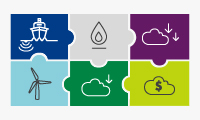Greenhouse gas emissions
Shell tracks emissions released by our upstream and downstream facilities and works to reduce air pollution from our operations.
We report our greenhouse gas (GHG) emissions in line with the recommendations of the Intergovernmental Panel on Climate Change. Shell’s Health, Safety, Security, Environment and Social Performance (HSSE&SP) Control Framework defines standards and accountabilities at each level of the organisation, and sets out the procedures people are required to follow. For example, our environmental standards include the requirement that all Shell-operated facilitites that generate more than 50,000 tonnes of GHG emissions have GHG and energy management plans.
Our performance
Our direct GHG emissions increased from 70 million tonnes carbon dioxide (CO2-equivalent) in 2016 to 73 million tonnes CO2-equivalent in 2017. Our 2016 base year GHG emissions did not change by more than 5% in 2017 and therefore the base year has not been recalculated.
Direct greenhouse gas emissions
million tonnes CO2 equivalent
Enlarge imageThe main reasons for the overall increase in our GHG emissions were the inclusion in our data from May 2017 of the facility previously operated by the Motiva joint venture in the USA and the return to production of previously shut-down units at the Bukom site in Singapore. These increases were partly offset by divestments (for example in Canada, Gabon, Malaysia and the UK) and reduced production at our Pearl gas-to-liquids (GTL) plant in Qatar.
In 2017, around 50% of our direct GHG emissions came from our refineries and chemical plants. The production of oil, gas and GTL products accounted for around 45% of our GHG emissions, and our shipping activities accounted for around 2%. We continue to work on improving operational performance and energy efficiency to manage GHG emissions.
The indirect GHG emissions associated with the generation of the energy we purchased (from electricity, heat and steam) were 12 million tonnes on a CO2 equivalent basis in 2017 compared with 11 million tonnes CO2 equivalent in 2016. The increase is mainly due to the inclusion of former Motiva refineries and a rise in production at our QGC facilities in Australia. These emissions were calculated using a market-based approach, as defined by the World Resources Institute GHG Protocol.
We estimate that the CO2 emissions from the use of our refinery and natural gas products by others were around 579 million tonnes in 2017, which represents less than 2% of the world's emissions.
(See more on www.shell.com/ghg)
GHG movements from 2016 to 2017 [A]
million tonnes CO2 equivalent
Enlarge image[A] Direct and energy indirect greenhouse gas emissions. Numbers have been rounded so some totals may not agree exactly.
[B] Does not include 1 million tonnes of CO2 captured and sequestered by our Quest CCS project in Canada in 2017.
 Sustainability at Shell
Sustainability at Shell
 Sustainable development goals
Sustainable development goals
 About our data
About our data
 Energy transition and climate change
Energy transition and climate change